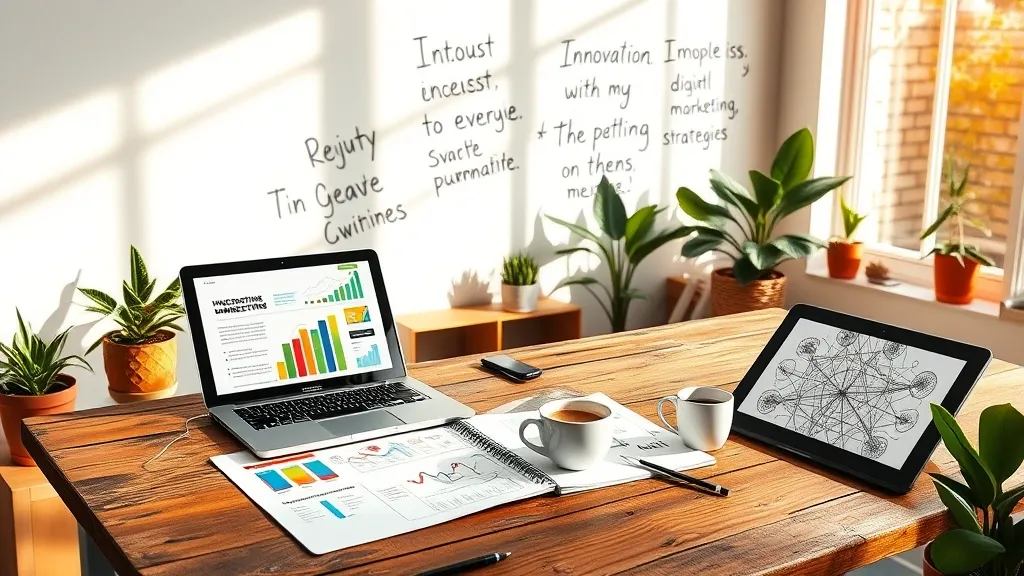The Dance of Aesthetics and Algorithms: How Design Sets the Stage for Success
Alright, let’s chat about something super important in the world of digital marketing and web design: the magical relationship between aesthetics and algorithms. Sounds fancy, right? But seriously, it’s like a dance where both partners need to know their moves to create something beautiful. If one stumbles, the whole thing can fall apart.
First off, let’s talk about aesthetics. You know when you land on a website that just feels right? The colors vibe, the fonts are easy on the eyes, and everything is laid out in a way that makes sense? That’s the power of good design. It’s like walking into a cozy coffee shop versus a dingy basement. You want to stick around, maybe even grab a latte and chill. A well-designed site can keep visitors engaged long enough for them to actually do something—like sign up for a newsletter or make a purchase. And let’s be real, we all want that.
Now, here’s where the algorithms come into play. They’re like the bouncers of the internet—deciding who gets in and who doesn’t. If your site is pretty but doesn’t load fast or isn’t mobile-friendly, those algorithms are gonna give you a big ol’ thumbs down. It’s like showing up to that coffee shop with a dress code and not being able to get in because you wore flip-flops. Bummer, right?
So, how do you balance these two? Well, it’s about finding that sweet spot where design meets functionality. A clean layout, intuitive navigation, and quick loading times are essential. Plus, let’s not forget about SEO. You can have the prettiest site in the world, but if it’s not optimized for search engines, it’s like shouting into a void. No one’s gonna hear you.
- Prioritize User Experience: Make sure your site is easy to navigate. If users can’t find what they’re looking for, they’ll bounce faster than I can finish a slice of pizza.
- Mobile Responsiveness: With so many folks browsing on their phones, your site needs to look good on all devices. No one wants to pinch and zoom just to read your content.
- Speed Matters: Aim for a fast-loading site. Patience is not a virtue people have online.
In the end, it’s all about creating a harmonious relationship between stunning design and the nitty-gritty of algorithms. When you get this right, that’s when you unlock the real potential of your digital marketing efforts. So, get out there and start dancing!
Content is King, but Design is the Crown: The Role of Visuals in Engagement
Okay, let’s be real for a moment. You can have the most mind-blowing content on the planet—an article that practically changes lives—but if it looks like it was made in the Stone Age, people might just scroll right past it. Sad but true! In the world of digital marketing, content is king, but let’s not forget that design is the crown. And a funky crown can totally make or break the monarchy, am I right?
Visuals play a massive role in grabbing attention. Think about it: when you’re browsing the web, what catches your eye first? A wall of text or a colorful image that pops? Yep, I thought so. A good design isn’t just about looking pretty; it helps guide the user experience. It’s like a friendly tour guide through the chaotic museum of the internet. You want your visitors to feel welcomed and engaged, not like they’ve wandered into a boring lecture.
- First Impressions Matter: You never get a second chance to make a first impression. A sleek website design can hook visitors instantly, while a cluttered layout might send them running for the hills.
- Brand Identity: Your design speaks volumes about who you are as a brand. It’s like your online outfit. Are you business casual, or do you rock the quirky T-shirt vibe? Your visuals should reflect your brand’s personality.
- Enhancing Readability: Good design can make content easier to digest. Proper use of fonts, colors, and spacing can turn a daunting block of text into a snackable treat. Nobody wants to read something that looks like a homework assignment!
And let’s not forget about mobile users. With everyone glued to their phones, having a responsive design is more crucial than ever. It’s like trying to fit your big head into a tiny hat—if it doesn’t fit, it’s just not gonna work! A mobile-friendly site makes sure your content is accessible to everyone, which is what we all want, right?
At the end of the day, combining killer content with eye-catching design is the secret sauce for keeping your audience engaged. So, don’t just throw a bunch of words onto a page and hope for the best. Craft your visuals to complement your content, and you’ll have a winning combo that’ll keep people coming back for more!
Crafting the User Journey: Where Design Meets Marketing Strategy
Alright, let’s dive into the nitty-gritty of how design and marketing strategies come together to create a killer user journey. It’s like peanut butter and jelly—each is great on its own, but together? Magic. Seriously, if you’ve ever tried to navigate a poorly designed website, you know exactly what I mean. It’s like walking through a maze with no exit. Frustrating, right?
So, when we talk about crafting the user journey, it’s all about understanding the path your visitors take on your site. Think of it as a road trip. You wouldn’t just hop in the car and drive without a map—unless you’re into spontaneous adventures, which can be fun but often leads to “Are we lost?” moments. The same goes for your website. If your users can’t find what they’re looking for, they’re hitting that back button faster than you can say “bounce rate.”
To get this journey just right, you need to blend design with your marketing strategy. Here’s how:
- Know Your Audience: First things first, understand who your users are. What do they want? What keeps them up at night? You gotta get in their heads a little.
- Map It Out: Create a user journey map. This is where you visualize every step a user takes from landing on your page to checking out. It’s like making a treasure map, but instead of gold, you’re leading them to a sweet deal.
- Design with Purpose: Every design element should have a reason for being there. Buttons should be obvious, and call-to-actions (CTAs) should practically jump off the page. If someone can’t find the “Buy Now” button, you might as well be hiding the cookies from a toddler.
- Test, Test, Test: Don’t forget to test your design! A/B testing can show you what works and what doesn’t. It’s like trying on clothes before you buy—sometimes, that cute top just doesn’t fit right.
In the end, a smooth user journey can significantly boost conversions. When design and marketing strategy play nice together, you not only keep your users happy but also increase the chances they’ll come back. And who doesn’t want loyal customers? Think of it as building a relationship—nurture it, and it’ll grow. So, let’s get out there and create some amazing user experiences!
Metrics and Magic: Measuring the Impact of a Harmonized Approach
Alright, let’s talk numbers! Because, let’s be real, no one likes to throw money at a problem without knowing if it’s gonna stick, right? When we’re blending digital marketing with web design, it’s like making a killer smoothie. You gotta find the right balance to make it delicious and nutritious—or in our case, effective and profitable!
First off, you gotta set some clear metrics to gauge how well your efforts are working together. Think of it as your GPS for success. You wouldn’t want to drive around aimlessly, right? Some key performance indicators (KPIs) to keep an eye on include:
- Traffic Sources: Where’s your audience coming from? Organic search, social media, or maybe they just stumbled into your site like a lost puppy? Knowing this helps you focus your marketing efforts.
- Conversion Rates: Are visitors doing what you want them to do—like signing up for newsletters or making purchases? If they’re just browsing, it’s like having a great party, but no one’s dancing.
- Engagement Metrics: This includes things like bounce rate and average session duration. If people are bouncing off your site faster than I can say “SEO,” you might need to tweak your design or content.
- Customer Feedback: This is pure gold. Listening to what your users think can be the game-changer. Sometimes they’re just full of surprises—like that one friend who always orders something weird at a restaurant, but it ends up being amazing!
Once you’ve got your metrics in place, it’s time to get your hands dirty and analyze the data. This is where the “magic” happens. You might find that a certain color scheme is attracting more clicks or that your social media posts are driving traffic like a champ. It’s all about finding those little nuggets of insight that can help you refine your strategy.
Oh, and don’t forget to A/B test! Seriously, it’s like dating—sometimes you just gotta try out a few options to see which one clicks. Split your audience and show them different versions of your site or ads to see what works best. Your metrics will tell you what’s hot and what’s not.
At the end of the day, measuring the impact of your harmonized approach is about being flexible and responsive. The digital world changes faster than the latest TikTok trend, and you gotta keep up! So, embrace the chaos, track those numbers, and let the magic of data guide your path to success. Happy measuring!

